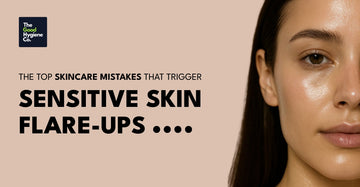If your skin often feels itchy, red, or stings after using everyday skincare products, you may be unknowingly making some common skincare mistakes that trigger sensitive skin flare-ups. Sensitive skin needs more than just gentle products; it needs the right skincare habits, tailored to avoid irritation, dryness, and long-term damage.
At The Good Hygiene Company, we believe that skincare should nourish not stress your skin. Let’s walk through the most common missteps people make and how you can avoid them to keep your skin calm, healthy, and resilient.
What is Sensitive Skin?
Sensitive skin is not a medical diagnosis but a symptom-based condition. It typically reacts with burning, redness, itching, or dryness when exposed to certain ingredients or environmental triggers.
Common symptoms include:
- Tightness after cleansing
- Stinging or burning sensation
- Redness or rashes
- Peeling or dry patches
- Frequent breakouts without a clear cause
Top Skincare Mistakes That Worsen Sensitive Skin
1. Over-Cleansing or Using Harsh Cleansers
Using harsh soaps or cleansers can strip your skin’s natural barrier, leading to more sensitive skin flare-ups.
Instead, choose:
- Soap free foaming cleansers
- pH-balanced formulations
- Products labeled as "fragrance-free" and "for sensitive skin"
Dermatologist Recommends:
The Good apple amino face foam – formulated by cosmetic dermatologist, pH-balanced, and free from common irritants.
2. Using Too Many Actives at Once
Layering retinol, AHAs, BHAs, or vitamin C all in one routine can overwhelm the skin, even if you use high-quality products.
What to do:
- Introduce one active ingredient at a time.
- Use actives on alternate days.
- Always buffer with a barrier-repair moisturizer.
Dermatologist Recommends:
The Good soothing skin serum – formulated by cosmetic dermatologist,milky serum that protects, lightens and improves dull skin
3. Ignoring Patch Tests
Skipping a patch test can lead to full-face irritation. Even "natural" products can cause reactions.
How to patch test:
- Apply a small amount on your jawline or inner arm.
- Wait 24–48 hours.
- Watch for redness, bumps, or itching.
4. Exfoliating Too Often
Sensitive skin doesn’t need daily exfoliation. Overdoing it damages your protective layer and leads to micro-tears and inflammation.
|
Type of Exfoliant |
Frequency (Sensitive Skin) |
|
Physical Scrubs |
Avoid completely |
|
Lactic Acid |
1x/week (mild strength) |
|
PHA (Gluconolactone) |
1–2x/week |
Dermatologist Recommends:
Avoid exfoliation if you're already experiencing a flare-up. Can use face wash with plant based exfoliants like the one in the good apple amino foam face wash
5. Using Fragranced Products
One of the first thing you should eliminate from your routine is synthetic fragrance. Fragrance whether natural or artificial is one of the most common irritant found in skincare. It can cause redness, stinging, itching, or delayed allergic reactions, especially in leave-on products like moisturizers, face serums, body lotions, and sunscreens. Even if a product smells mild, the compounds used to create that scent may compromise your skin barrier over time.
This is especially important for people dealing with eczema-prone, rosacea-prone, or reactive skin, where any added irritant can escalate symptoms.
Tips for choosing skin-safe products:
- Always look for labels that say “fragrance-free” – not just “unscented” (which may still contain masking agents)
- Prioritize formulas labeled “hypoallergenic”, “non-comedogenic”, or “dermatologist-tested for sensitive skin”
- Be cautious even with products marketed as “natural” or “botanical” many essential oils used for scent (like citrus, lavender, or peppermint) can be just as irritating as synthetic fragrances
At The Good Hygiene Company, all our sensitive-skin essentials are fragrance-free and formulated without essential oils or allergens, offering calm and comfort for truly delicate skin.
6. Skipping Moisturizer
Even oily or acne-prone skin needs moisture. Skipping it makes your skin produce more oil to compensate, increasing sensitivity.
Choose moisturizers that contain:
- Ceramides
- Hyaluronic acid
- Plant-based emollients (like shea butter or squalane)
Dermatologist Recommends:
The Good Replenishing Body Butter – rich in plant oils, ceramides, and ideal for sensitive, dry skin prone to flare-ups.
7. Not Wearing Sunscreen Daily
UV rays break down collagen and compromise your skin barrier. Many people with sensitive skin avoid sunscreen fearing breakouts but this can worsen sensitivity in the long run.
Opt for:
- Mineral sunscreens with zinc oxide or titanium dioxide
- SPF 30 or higher
- Non-comedogenic, fragrance-free formulas
8. Applying Products in the Wrong Order
Incorrect layering can block actives from working and worsen irritation.
Correct routine order:
- Cleanser
- Toner (optional, alcohol-free)
- Treatment serum (like niacinamide)
- Moisturizer
- Sunscreen (AM only)
9. Overusing Barrier Creams or Occlusives
Ironically, using too many occlusive layers (like thick balms or petroleum jelly) can suffocate the skin, trap heat, and lead to milia, breakouts, or congestion.
What to do:
- Use occlusives only at night and only in dry/cold weather
- Let skin breathe during the day
10. Poor Sleep and High Cortisol Levels
Lack of sleep increases cortisol, which inflames skin and worsens conditions like eczema, rosacea, or acne all linked with sensitive skin.
Remedy:
- Maintain consistent sleep schedule
- Incorporate calming rituals like chamomile tea or magnesium sprays
Myth-Busting: What Sensitive Skin Users Often Get Wrong
1. “If it’s natural, it must be safe.”
Truth: Lavender oil, lemon peel, and menthol are natural but highly irritating to sensitive skin.
2. “My skin is oily so I don’t need moisturizer.”
Truth: Even oily skin can be dehydrated. Skipping moisturizer worsens barrier breakdown.
3. “Sensitive skin can’t tolerate any actives.”
Truth: You can use actives just buffer them and go slow. Niacinamide, azelaic acid, and PHA are great options.
Conclusion:
Sensitive skin isn’t something you have to “put up with.” By avoiding these common skincare mistakes, and switching to science-backed, plant-safe products, you can stop flare-ups before they start.
References:
1. A review of factors influencing sensitive skin: an emphasis on built environment characteristics - 2023 Dec - https://pmc.ncbi.nlm.nih.gov/articles/PMC10726041/
2. Mechanisms of Sensitive Skin and the Soothing Effects of Active Compounds: A Review- https://www.mdpi.com/2079-9284/11/6/190
3. The Prevalence of Sensitive Skin - 2019 May - https://pmc.ncbi.nlm.nih.gov/articles/PMC6533878/
4. Sensitive skin: review of an ascending concept* - 2017 Jun - https://pmc.ncbi.nlm.nih.gov/articles/PMC5595600/





